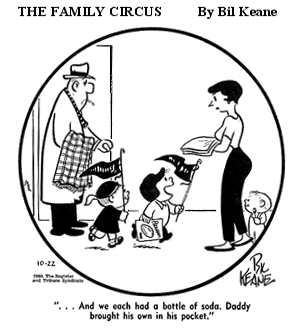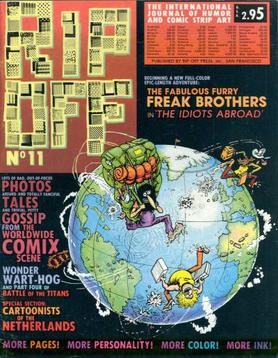Related Research Articles

Ruben Bolling is a pseudonym for Ken Fisher, an American cartoonist, the author of Tom the Dancing Bug. His work started out apolitical, instead featuring absurdist humor, parodying comic strip conventions, or critiquing celebrity culture. He came to increasingly satirize conservative politics after the September 11 attacks and Iraq war in the early 2000s. This trend strengthened with the Donald Trump presidency and right-wing populism from 2017-2020, his critiques of which earned him several cartooning awards.

The Family Circus is a syndicated comic strip created by cartoonist Bil Keane and, since Keane's death in 2011, is written, inked and rendered (colored) by his son Jeff Keane. The strip generally uses a single captioned panel with a round border, hence the original name of the series, which was changed following objections from the magazine Family Circle. The series debuted February 29, 1960 and has been in continuous production ever since. According to publisher King Features Syndicate, it is the most widely syndicated cartoon panel in the world, appearing in 1,500 newspapers. Compilations of Family Circus comic strips have sold more than 13 million copies worldwide.

Fritz the Cat is a comic strip created by Robert Crumb. Set in a "supercity" of anthropomorphic animals, it focused on Fritz, a tabby cat who frequently went on wild adventures that sometimes involved sexual escapades. Crumb began drawing the character in homemade comic books as a child, and Fritz would become one of his best-known characters.

Harvey Kurtzman was an American cartoonist and editor. His best-known work includes writing and editing the parodic comic book Mad from 1952 until 1956, and writing the Little Annie Fanny strips in Playboy from 1962 until 1988. His work is noted for its satire and parody of popular culture, social critique, and attention to detail. Kurtzman's working method has been likened to that of an auteur, and he expected those who illustrated his stories to follow his layouts strictly.

"Omaha" the Cat Dancer is an erotic comic strip and later comic book created by artist Reed Waller and writer Kate Worley. Set in fictional Mipple City, Minnesota in a universe populated by anthropomorphic animal characters, the strip is a soap opera focusing on Omaha, a feline exotic dancer, and her lover, Chuck, the son of a business tycoon.

Non Sequitur is a comic strip created by Wiley Miller starting February 16, 1992 and syndicated by Andrews McMeel Syndication to over 700 newspapers. It is also published on gocomics.com and distributed via email.

William Henry Jackson Griffith is an American cartoonist who signs his work Bill Griffith and Griffy. He is best known for his surreal daily comic strip Zippy. The catchphrase "Are we having fun yet?" is credited to Griffith.

David Wiley Miller is an American cartoonist whose work is characterized by wry wit and trenchant social satire, is best known for his comic strip Non Sequitur, which he signs Wiley. Non Sequitur is the only cartoon to win National Cartoonists Society Divisional Awards in both the comic strip and comic panel categories, and Miller is the only cartoonist to win an NCS Divisional Award in his first year of syndication.

Jen Sorensen is an American cartoonist and illustrator who creates a weekly comic strip that often focuses on current events from a liberal perspective. Her work has appeared on the websites Daily Kos, Splinter, The Nib, Politico, AlterNet, and Truthout; and has appeared in Ms. Magazine, The Progressive, and The Nation. It also appears in over 20 alternative newsweeklies throughout America. In 2014 she became the first woman to win the Herblock Prize, and in 2017 she was named a Pulitzer Finalist in Editorial Cartooning.

Henry Boltinoff was an American cartoonist who worked for both comic strips and comic books. He was a prolific cartoonist and drew many of the humor and filler strips that appeared in National Periodical comics from the 1940s through the 1960s.

Jay Patrick Lynch was an American cartoonist who played a key role in the underground comix movement with his Bijou Funnies and other titles. He is best known for his comic strip Nard n' Pat and the running gag Um tut sut. His work is sometimes signed Jayzey Lynch. Lynch was the main writer for Bazooka Joe comics from 1967 to 1990; he contributed to Mad, and in the 2000s expanded into the children's book field.
Funny Times (FT) is an American humor newspaper founded in 1985, and still published as of 2023, by the wife and husband team of Susan Wolpert and Raymond Lesser. Wolpert and Lesser were inspired by The Comic News of Santa Cruz, California, "a monthly journal of progressive editorial cartoons" founded in 1984 by Thom Zajac. FT's political content is often subversive and has a progressive/liberal perspective.

Rip Off Comix was an underground comix anthology published between 1977 and 1991 by Rip Off Press. As time passed, the sensibility of the anthology changed from underground to alternative comics.

Gary Hallgren is an American illustrator and underground cartoonist. Illustrations by Hallgren have been "commissioned by publications such as The New York Times, Men's Health, The Wall Street Journal, Mad, and Entertainment Weekly, among others."
Attitude: The New Subversive Cartoonists is a series of anthologies of alternative comics, photos and artists' interviews edited by Universal Press Syndicate editorial cartoonist Ted Rall. The books were designed by J. P. Trostle, news editor of EditorialCartoonists.com. Two sequels and three spin-off titles have been published to date. A group of cartoonists featured in the Attitude series formed the organization Cartoonists With Attitude in June 2006; the group has hosted slideshow and panel events around the United States to promote the series and alternative political cartooning. The New Labor Forum described the series as "filled with politically attuned graphic artistry."
Cul de Sac is an American comic strip created by Richard Thompson. It was distributed by Universal Press Syndicate/Universal Uclick to 150 worldwide newspapers from 2004 to 2012.
Richard Edward "Grass" Green was an African American cartoonist notable for being the first black participant in both the 1960s fan art movement and the 1970s underground comics movement. In the 1960s, Green's Harvey Kurtzman-like zany, action-packed, humorous comics parodies appeared in numerous fanzines. His "outrageous" 1970s and 1980s underground work used searing humor to expose America's racism and bigotry.

Andrews McMeel Syndication is an American content syndicate which provides syndication in print, online and on mobile devices for a number of lifestyle and opinion columns, comic strips and cartoons and various other content. Some of its best-known products include Dear Abby, Doonesbury, Ziggy, Garfield, Ann Coulter, Richard Roeper and News of the Weird. A subsidiary of Andrews McMeel Universal, it is headquartered in Kansas City, Missouri. It was formed in 2009 and renamed in January 2017.
Although, traditionally, female comics creators have long been a minority in the industry, they have made a notable impact since the very beginning, and more and more female artists are getting recognition along with the maturing of the medium. Women creators have worked in every genre, from superheroes to romance, westerns to war, crime to horror.
References
- ↑ Gardner, Alan. Ruben Bolling Wins Best Cartoon Award from AAN Archived 2021-03-03 at the Wayback Machine . The Daily Cartoonist (June 10, 2008)
- ↑ Xerexes, Xavier. Onward Into the Webcomics Breach Archived 2021-03-01 at the Wayback Machine . Comix Talk (July 1, 2009)
- ↑ "Tom the Dancing Bug Blog". Gocomics.typepad.com. Archived from the original on 2014-02-22. Retrieved 2014-02-22.
- ↑ FULL LIST: 2018 Robert F. Kennedy Book & Journalism Award Winners Archived 2021-02-25 at the Wayback Machine (May 3, 2018)
- ↑ "'Tom The Dancing Bug' Creator Ruben Bolling Awarded The 2017 Herblock Prize". GoComics. Archived from the original on 2018-03-03. Retrieved 2022-08-31.
- ↑ "Ruben Bolling (Pen name of Ken Fisher) | the Herb Block Foundation". Archived from the original on 2017-03-06. Retrieved 2017-03-06.
- ↑ Degg, D. D. (May 11, 2022). "Ruben Bolling Wins 2021 Berryman Award". The Daily Cartoonist. Archived from the original on January 17, 2024. Retrieved January 17, 2024.
- ↑ "Ruben Bolling wins 2021 Berryman Cartoonist Award". National Press Foundation. November 1, 2021. Archived from the original on January 20, 2022. Retrieved May 11, 2022.
- 1 2 3 Winning Editorial Cartoonist Accepts Berryman Award Archived 2022-05-11 at the Wayback Machine (May 10, 2022)
- ↑ "Finalist in editorial cartooning: Ken Fisher, drawing as Ruben Bolling, freelancer". Pulitzer Prize. 2019. Archived from the original on 2021-03-08. Retrieved 2021-03-20.
- ↑ "Finalist: Ken Fisher, drawing as Ruben Bolling, for "Tom the Dancing Bug," Andrews McMeel Syndicate". Pulitzer Prize. 2021. Archived from the original on 2021-06-13. Retrieved 2021-06-13.
- 1 2 Pikul, Corrie (2005-01-14). "The mystery man behind "Tom the Dancing Bug"". Archived from the original on 2006-07-19.
- ↑ @RubenBolling (March 21, 2021). "This is sadly true. Tom the Dancing Bug used to be in well over 100 print newspapers, and for a while in the NYT ab…" (Tweet) – via Twitter.
- ↑ Bolling, Ruben (2010-03-22). "Salon, so long". Archived from the original on 2010-03-25. Retrieved 2010-03-29.
Salon.com has informed me that they have canceled Tom the Dancing Bug.... I was told that the cancellation was made because of 'severe budget constraints,' and that traffic for the comic continued to be good.
- ↑ Bolling, Reuben (May 9, 2012). "Come on and join Tom the Dancing Bug's INNER HIVE!". Boing Boing. Archived from the original on 2015-07-29. Retrieved 2021-03-20.
- ↑ Roth, Stephen (November 26, 2018). "Politics Through the Compound Eyes of 'Tom the Dancing Bug". GoComics. Archived from the original on 2021-04-18. Retrieved 2021-03-20.
- ↑ Manjoo, Farhad (2002), "March of the "lucky duckies"", Salon, archived from the original on 2024-05-20, retrieved 2010-05-13
- ↑ Bolonik, Kera (2006). "The world according to Ruben Bolling". Archived from the original on 2009-11-04. Retrieved 2010-11-19.
- ↑ Bolling, Ruben. "Super-Fun-Pak Comix by Ruben Bolling". GoComics. Archived from the original on 2020-04-16. Retrieved 2020-04-27.
- ↑ Bolling, Ruben (2001-09-29). "Tom the Dancing Bug Comic Strip, September 29, 2001 on GoComics.com". Tom the Dancing Bug. GoComics.com. Archived from the original on 2010-07-11. Retrieved 13 May 2010.